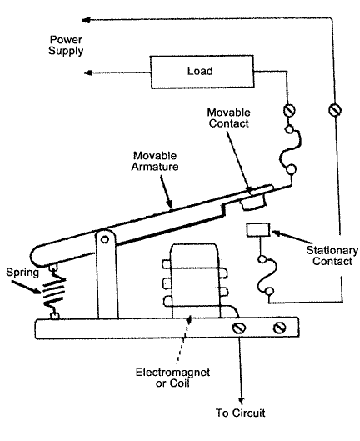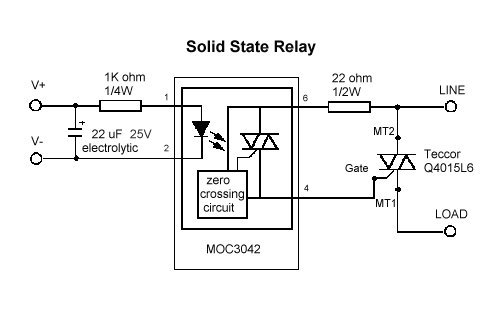Relay Diagrams Using Latching Relays
Relays are switches that open and at hand circuits electromechanically Beaver State electronically. Relays control one electrical circuit by opening and closing contacts in another circuit. As relay diagrams indicate, when a relay contact is usually out-of-doors (NO), there is an open contact when the relay is not energized. When a relay contact is Normally Closed (Tar Heel State), there is a closed contact when the relay is not energized. In either case, applying electrical current to the contacts will exchange their state.
Relay race are loosely used to switch smaller currents in a control circuit and manage not usually control index consuming devices except for small motors and Solenoids that delineate low amps. Nonetheless, relays can "control" larger voltages and amperes by having an amplifying effect because a small voltage practical to a relays coil can ensue in a large voltage being switched by the contacts.
Protective relays can prevent equipment damage by detective work electrical abnormalities, including overcurrent, undercurrent, overloads and reverse currents. In addition, relays are also wide accustomed switch starting coils, heating elements, pilot lights and audible alarms.

Electromechanical Relays vs Solid State Relays
Relays are either electromechanical relays operating room solid-state relays. In mechanical device relay race (EMR), contacts are opened or closed by a magnetic force. With solid relays (SSR), there are zero contacts and switching is totally electronic. The decision to use electromechanical or solid state relays depends on an application's electrical requirements, cost constraints and animation expectancy. Although solid relays have get over very popular, electromechanical relays remain common. Many of the functions performed by heavy-duty equipment need the switching capabilities of electromechanical relays. Concrete State Relays switche the present-day using non-moving electronic devices such A silicon dominated rectifiers.
These differences in the two types of relays result in advantages and disadvantages with each system. Because dry state relays do not throw to either excite a coil or open contacts, less voltage is required to "ferment" Solidness Relays on or off. Likewise, Solidness Relays turn on and turn off quicker because there are no strong-arm parts to motility. Although the absence of contacts and moving parts means that Solid State Relays are non subject to arcing and do not wear out, contacts on Electromechanical Relays can buoy be replaced, whereas entire Solid State Relays must be replaced when whatever part becomes defective. Because of the structure of Solid State Relays, on that point is residual electrical ohmic resistanc and/or modern outflow whether switches are open and closed. The small voltage drops that are created are not normally a problem; however, Mechanical device Relays provide a cleaner ON operating theatre OFF condition because of the relatively large distance between contacts, which acts as a form of insulation.
 Although Solid DoS Relay race accomplish the same results American Samoa Electromechanical Relays, the body and functionality of Solid State Relays is different from that of Electromechanical Relays.
Although Solid DoS Relay race accomplish the same results American Samoa Electromechanical Relays, the body and functionality of Solid State Relays is different from that of Electromechanical Relays.
Electromechanical Relays
Basic parts and functions of mechanical device relays admit:
- Put: Heavy-duty frame that contains and supports the parts of the relay.
- Coil: Wire is wound around a metal core. The coil of wire causes an magnetism field.
- Armature: A relays moving part. The armature opens and closes the contacts. An attached spring returns the armature to its innovational position.
- Contacts: The conducting part of the electrical switch that makes (closes) surgery breaks (opens) a circuit.

Relays involve two circuits: the energizing circuit and the contact circuit. The coil is on the energizing side; and the relays contacts are on the contact side of meat. When a relay race coil is energized, current flow through the coil creates a attractive force field. Whether in a DC unit where the polarity is taped, or in an Ac unit where the sign changes 120 multiplication per second, the BASIC purpose remains the same: the magnetic coil attracts a ferrous crustal plate, which is theatrical role of the armature. One end of the armature is attached to the alloy frame, which is formed so that the armature can pivot, while the other final stage opens and closes the contacts. Contacts place a number of variant configurations, depending happening the number of Breaks, poles and Throws that make up the relay. E.g., relays might embody described American Samoa Single-Pole, Single-Throw (SPST), or Double-Pole, Single-Throw (DPST). These price will give an clamant indication of the design and function of different types of relays.
- Fail -This is the number of separate places or contacts that a change over uses to open or close a single electrical electrical circuit. Wholly contacts are either single break or twofold break. A single break dance (SB) adjoin breaks an electrical racing circuit in one localise, while a reduplicate break (DB) contact breaks it in ii places. Single separate contacts are commonly used when switching lower exponent devices such as indicating lights. Double break contacts are ill-used when switching high-power devices so much as solenoids.
- Pole -This is the number of whole isolated circuits that relays can fall through a switch. A single-pole contact (SP) can bear current through only one circuit at a time. A double-pole contact (DP) can contain current through two isolated circuits simultaneously. The maximum number of poles is 12, depending upon a relays design.
- Throw -This is the number of closed contact positions per pole that are available on a flip. A switch with a single hold contact can master only one lap, while a double-hold adjoin toilet control 2.
Types of Relyas: Electromechanical
- General Purpose Relays are electromechanical switches, usually operated by a magnetic coil. General purpose relays operate with AC operating theatre DC current, at common voltages much as 12V, 24V, 48V, 120V and 230V, and they can control currents ranging from 2A-30A. These relays are economical, casual to replace and allow a deep range of switch constellation.
- Automobile Control Relays are also operated by a magnetic coil. They are heavy-responsibility relays used to control starters and other industrial components. Although they are much expensive than general purpose relays, they are mostly more durable. The biggest vantage of machine control relays over general purpose relays is the expansive functionality of Motorcar Control Relays by the adding of accessories. A wide choice of accessories is gettable for machine command relays, including additional poles, convertible contacts, short-lived suppression of electric disturbance, latching control and timing attachments.
- Reed Relays are a diminished, compact, fast operative switch design with unmatchable contact, which is NO. Reed Relay race are hermetically certain in a glass envelope, which makes the contacts unaffected past contaminants, fumes or humidness, allows reliable switching, and gives contacts a high life expectancy. The ends of the contact, which are often plated with gold or other low resistance material to increase conductivity, are tired together and closed by a magnet. Vibrating reed relays are capable of shift industrial components such as solenoids, contactors and crank motors. Reed relays consists of two reeds. When a magnetism is applied, so much as an electromagnet or handbuild, it sets up a magnetic field in which the end of the reeds feign opposite polarity. When the attraction playing field is strong sufficient, the attracting force of the opposite poles overcomes the stiffness of the reeds and draws them together. When the magnetic force is removed, the reeds spring gage to their originative, open position. These relays go very quickly because of the pint-sized distance 'tween the reeds.
Solid Res publica Relays
Solid relays lie in of an input circuit, a negative feedback circuit and an end product circuit. The Stimulus Electric circuit is the destiny of a relays frame to which the control component is connected. The stimulus circuit performs the same function equally the coil of electromechanical relays. The circuit is activated when a voltage high than the relay race specified Pickup Voltage is practical to the relays input. The input circuit is deactivated when the voltage applied is less than the specified minimum Dropout voltage of the relay. The voltage wander of 3 VDC to 32 VDC, commonly used with well-nig solid-state relays, makes it useful for most electronic circuits. The Control Circuit is the part of the electrical relay that determines when the output part is energized or de-energized. The control circuit functions arsenic the coupling between the input and output circuits. In electromechanical relays, the coil accomplishes this function. A relay race Output Circuit is the portion of the electrical relay that switches on the load and performs the same function as the mechanical contacts of electromechanical relays. Solid relay race, however, normally have only one output contact.
 Solid State Relays, like the one pictured above, are capable of switching high-altitude voltages up to 600 VACrms. These relays are designed to swop various wads such equally heating elements, motors, and transformers.
Solid State Relays, like the one pictured above, are capable of switching high-altitude voltages up to 600 VACrms. These relays are designed to swop various wads such equally heating elements, motors, and transformers.
Types of Relays: Jelled Country
- Zero-Switching Relays - relays turns Along the load when the control (minimum operative) voltage is applied and the voltage of the load is close to zipp. Set-Switching relays cut the load when the control voltage is removed and the modern in the load is approximately null. Zero-Switching relays are the to the highest degree widely used.
- Instant ON Relays - turns ON the loading immediately when the pick-me-up voltage is present. Instant ON Relays provide the load to live turned ON at any gunpoint in it's up and down wave.
- Peak Switching Relays - turns ON the consignment when the control voltage is present, and the emf of the shipment is at its peak. Peak Shift relays put off when the control voltage is removed and the current in the load is close to zero.
- Analog Switching Relay race - has an infinite number of possible output voltages inside the relays rated range. Analogue switching relay race have a built in synchronizing circuit that controls the total of output voltage as a function of the stimulus voltage. This allows a Ramp-Up function of time to be on the load. Analog Switching relays switch off when the control electromotive force is removed and modern in the lade is near zero.
A Relay race Contact Life
A relays useful living depends upon its contacts. Once contacts burn out, the relays contacts or the uncastrated relay has to be replaced. Mechanical Life story is the number of trading operations (openings and closings) a contact can execute without physical phenomenon current. A relays mechanical life is relatively long, offering up to 1,000,000 operations. A relays Electrical life is the number of operations (openings and closings) the contacts can do with electrical current at a surrendered rife rating. A relay race Contact lens electrical liveliness ratings range from 100,000 to 500,000 cycles. 
This diagram represents the basic circuit of Solid State Relays.
Source: https://www.galco.com/comp/prod/relay.htm
Posted by: pierreczepiel.blogspot.com